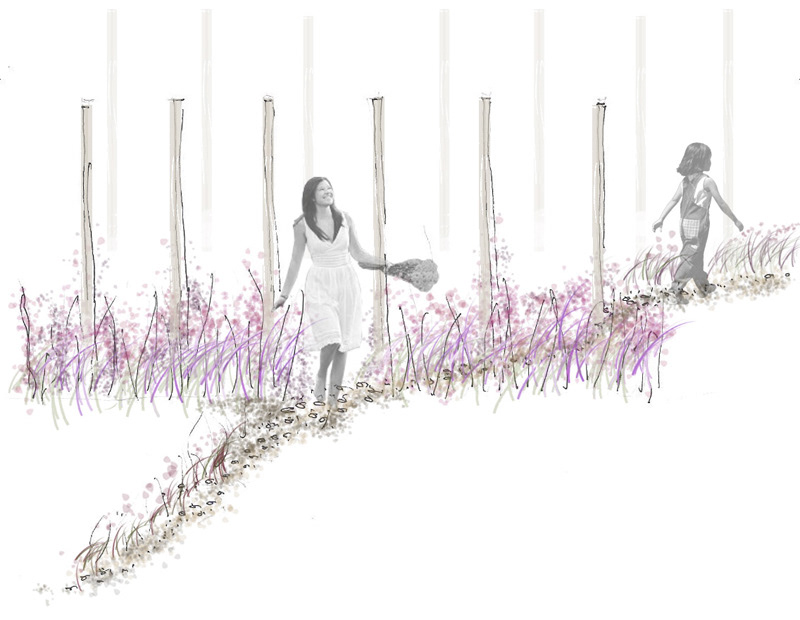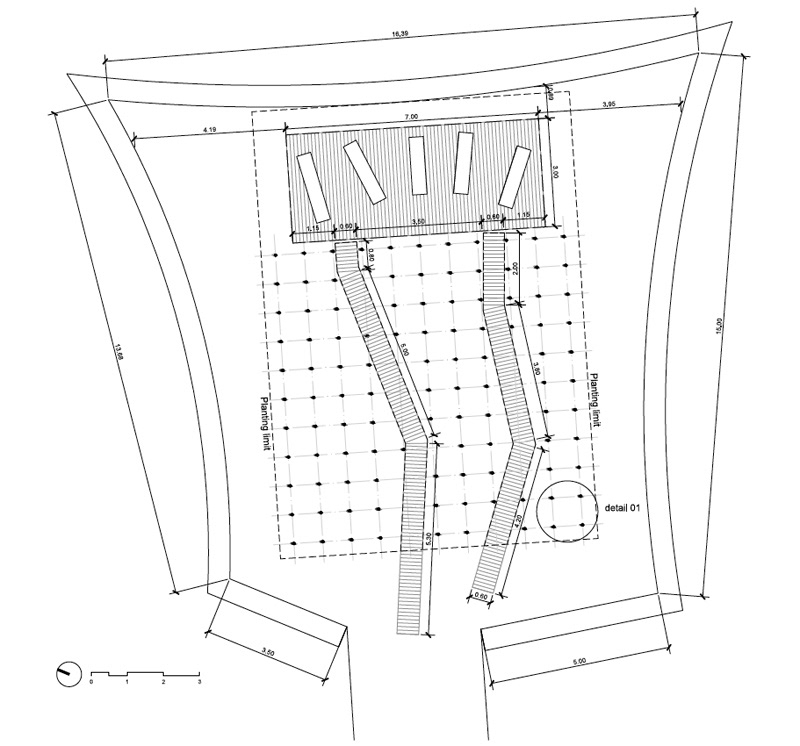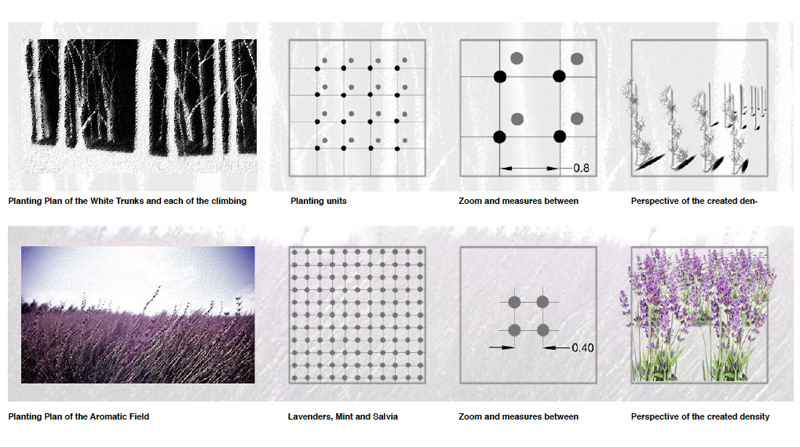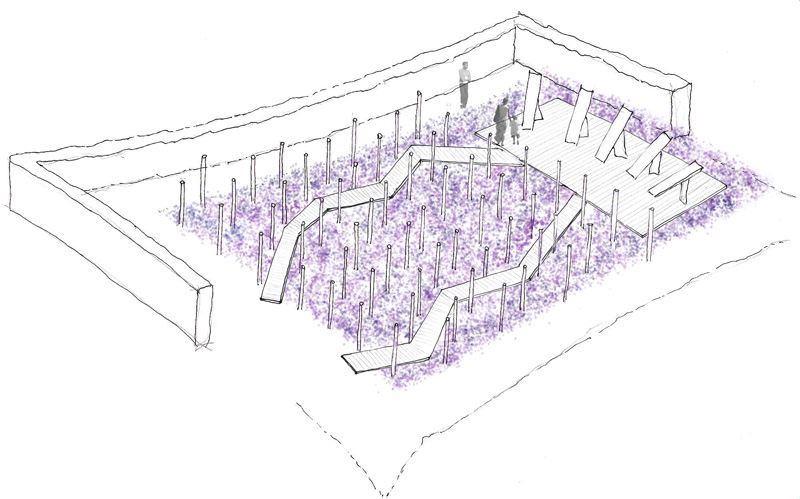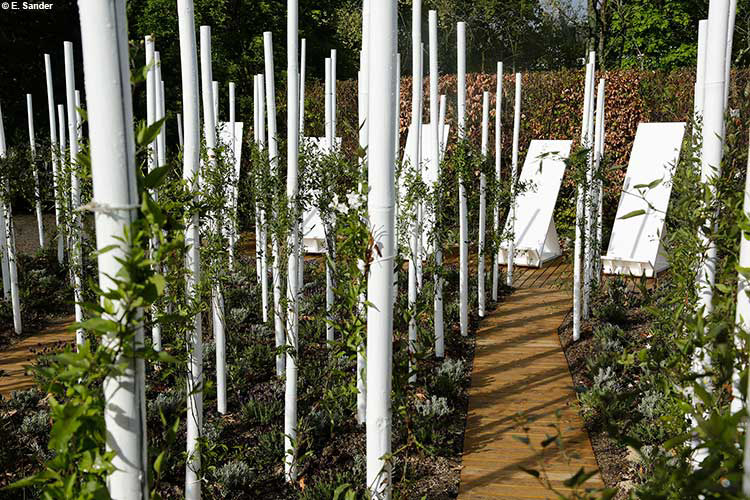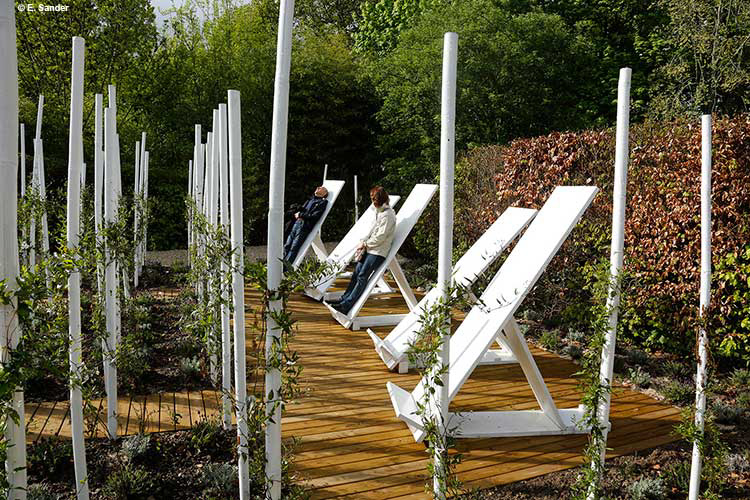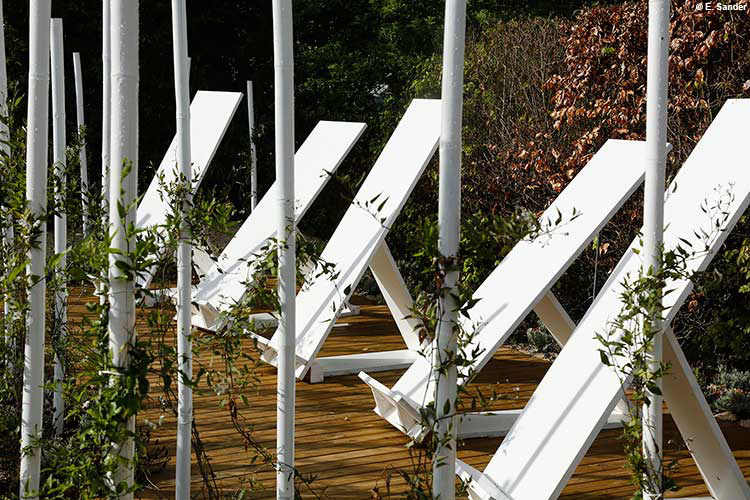The smell of the beautiful chaos
La idea de la propuesta es jugar con diferentes experiencias contrastadas dentro del jardín, que nos generen sensaciones particulares asociadas a cada experiencia. La experiencia de la vivencia del jardín desde el "interior", contacto, densidad, roce, aroma…y la experiencia desde el "exterior" del jardín a través de la simple contemplación.
Se plantea la experiencia de la "densidad y el contacto" a través de generar un bosque denso de elementos de madera verticales unificados. Otorga un ritmo continuo al espacio (reinterpretación del árbol) dando un grado de desorientación al visitante, que descansa sobre un campo muy denso y homogéneo de lavandas aromáticas. Este bosque se vive a través de unos caminos de madera con una trayectoria en zig-zag, escondidos en el interior de la vegetación.
La experiencia en este jardín trata de producir la sensación del contacto con la piel a través del roce con las lavandas, la sensación de contención en un interior, de sentir el ruido de la grava al caminar sobre ella, de impregnarse con el aroma del campo de flores. Al caminar en este bosque, al travesarlo, nos sentimos contenidos por un mar de sensaciones propias de él.
Después de vivir la experiencia del "interior" dentro del bosque, al final de este jardín se encuentra el regalo que este nos ofrece…un lugar más despejado donde poder estar, donde poder permanecer y descansar, disfrutar del placer sobre el manto denso de lavandas, manteniendo el roce de estas y sintiendo su aroma en todo momento. Este interior queda aislado del exterior por el bosque blanco de árboles, es el secreto del jardín que se nos ofrece como un regalo.
El bosque blanco esta contenido por un recorrido perimetral crujiente (mulch, hojas secas, grava), que se hace notar a través del ruido que generan los pasos sobre el. Desde este recorrido perimetral sólo se permite contemplar desde el exterior el jardín, este no se conecta con su interior. Esta última experiencia la de la contemplación desde el exterior, refleja una realidad encontrada en muchos que sólo experimentan el jardín a través de la mirada.
+ + +
The idea of the proposal is to play with different contrasting experiences in the garden. The first experience is from the “inside”, living the contact, density, touch, smell, noise when walking... the confusion of vertical and horizontal order... This is achieved crossing the garden through a “thick field of lavenders”.
The second experience is from the “outside” of the garden, through the simple contemplation. A framework of mulch that is not entering the field, contains the lavender garden. This leads the visitor to have the opportunity only to stay in the frame without entering the field... the opportunity to contemplate and admire from the outside.
The experience of “density and contact” is achieved by generating a forest of white vertical wooden elements. It provides a continuous rhythm to the space (representing the tree) giving a degree of disorientation to the visitor. The person rests on a very dense and homogeneous field of aromatic colored lavenders and crosses the wild roses that grow climbing upon the white trees. This forest is lived through some winding gravel paths hidden in the secret of the vegetation that allows the visitor to go through.
The sequence without references leads to disorientation, which is interpreted as “chaos” in the proposal. After living the experience of the “inside” into the forest, a hidden secret is located at the end of the garden; a clear place where you can stay, relax... and just enjoy the pleasure of the aroma of the dense mantle of lavenders, maintaining the contact with them. This “inside” is isolated from the outside because of the white forest. The visitor who dares to cross it will trap the secret garden, which is offered as a gift.
The second experience is from the “outside” of the garden, through the simple contemplation. A framework of mulch that is not entering the field, contains the lavender garden. This leads the visitor to have the opportunity only to stay in the frame without entering the field... the opportunity to contemplate and admire from the outside.
The experience of “density and contact” is achieved by generating a forest of white vertical wooden elements. It provides a continuous rhythm to the space (representing the tree) giving a degree of disorientation to the visitor. The person rests on a very dense and homogeneous field of aromatic colored lavenders and crosses the wild roses that grow climbing upon the white trees. This forest is lived through some winding gravel paths hidden in the secret of the vegetation that allows the visitor to go through.
The sequence without references leads to disorientation, which is interpreted as “chaos” in the proposal. After living the experience of the “inside” into the forest, a hidden secret is located at the end of the garden; a clear place where you can stay, relax... and just enjoy the pleasure of the aroma of the dense mantle of lavenders, maintaining the contact with them. This “inside” is isolated from the outside because of the white forest. The visitor who dares to cross it will trap the secret garden, which is offered as a gift.
